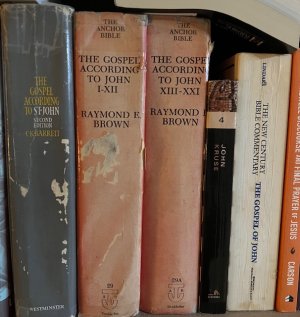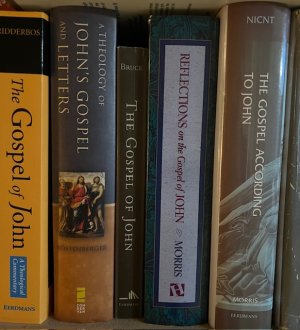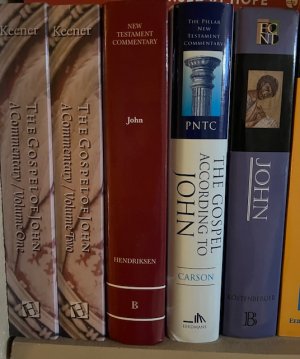Point 2 –
This point is based on some research I did a few years back and a presentation I did at SBL in 2021 on John 6:35–40, the first part of the bread of life discourse. I want to present a summary of this before I approach John 6:41–51 because the same approach can be used there.
I want to start by saying this summary may not do the whole study justice, but I do offer it as a starting point for further investigation.
When examining 6:35–40, I noticed a difference in pronouns that most had ignored or explained away. In verses 37 and 39, John (speaking for Jesus) used the neuter PAN (“everything”) to describe what was given to Jesus. He then switches to the masculine PAS (“everyone”) when speaking of people who come to him.
The common interpretation of this was that the neuter was simply being used as a masculine and this referred to “everyone” who the Father gives to Jesus. Indeed, even the NIV translated this as “All whom the Father gives me . . .” Rudolf Schnackenburg goes so far as to say the use of the neuter for the masculine is common. Others, like Ray Brown, F. F. Bruce and Max Zerwick, suggest that the use of the neuter denotes a corporate giving to Christ. That is, the Father gives all who believe in Jesus.
While the idea of a corporate giving was compelling (particularly for Arminians), I did not find it satisfying. It really did not explain why John would use the masculine “all” (PAS) a few verses later (6:40, 45) to refer to people, nor did it appear consistent with the use of the masculine participle in the same context. Upon investigating how the neuter PAN was used elsewhere, I could find none that matched Schnackenburg’s claim. Instead, they all followed the general rule for relative pronouns (which PAN is modifying), which states it agrees in gender and number with the noun or pronoun to which it refers. A secondary rule that fits best with this is that it refers back to a whole clause before the pronoun.
The antecedent to this statement is defined in the question posed by the crowd:
30 So they said to him, “
What sign (neuter) are you going to give us then, so that we may see it and believe you? What work (neuter) are you performing? 31 Our ancestors ate the manna in the wilderness; as it is written, ‘He gave them bread from heaven to eat.’ ” (John 6:30–31 NRSV)
This is the question that Jesus is answering.
I know this is very technical, but let us look at the text of John 6:35–40. I have outlined it below to see the parallels to the response to the crowd. I am going to label the parts “C” (for Claim) and “R” (for Response) so you can see the format of the parallels in what Jesus is saying. Verse 36 is an interposed comment about the crowd’s actual response. Hence I am showing it in parentheses.
C—35 Jesus said to them, “I am the bread of life.
R—Whoever comes to me will never be hungry, and whoever believes in me will never be thirsty.
(36 But I said to you that you have seen me and yet do not believe. )
C—37 Everything that the Father gives me will come to me,
R—and anyone who comes to me I will never drive away;
C—38 for I have come down from heaven, not to do my own will, but the will of him who sent me. 39 And this is the will of him who sent me, that I should lose nothing of all that he has given me, but raise it up on the last day.
R—40 This is indeed the will of my Father, that all who see the Son and believe in him may have eternal life; and I will raise them up on the last day.”
[1]
So what does this tell us?
Jesus is making a series of claims about himself and his work and then showing the proper response to that work. The proper response is to "believe" or “come to me.” The terms are used as equivalent acts. Those who come or believe are raised up on the last day. That is, they are given eternal life. Whether you agree with my prior analysis or not about the definition of the “last day” in John, the condition for being raised up is belief. That is the proper response to the work, repeated three times in the text. Those who do not believe will not participate in the eschatological reign of God on the last day.
Coming to Jesus, and seeing and believing all equate to the same thing—we must believe in Jesus as the Son of God and Messiah to receive eternal life. (See also, John 3:13–18 for an equivalent passage.)
So does this same type of flow apply to John 6:41–47? Absolutely.
John 6:41–42 raised a complaint by the Jews (not the crowd, but the Jewish authorities of the synagogue) about Jesus’ claim that he is the bread that came down from heaven. We have that same format in Jesus’s reply.
41 Then the Jews began to complain about him because he said, “I am the bread that came down from heaven.” 42 They were saying, “Is not this Jesus, the son of Joseph, whose father and mother we know? How can he now say, ‘I have come down from heaven’?”
Establishes the fundamental concern—Jesus as the bread that came down from heaven.
C—43 Jesus answered them, “Do not complain among yourselves. 44 No one can come to me unless drawn by the Father who sent me;
R—and I will raise that person up on the last day.
C—45 It is written in the prophets, ‘And they shall all be taught by God.’
R—Everyone who has heard and learned from the Father comes to me.
C—46 Not that anyone has seen the Father except the one who is from God; he has seen the Father.
R—47 Very truly, I tell you, whoever believes has eternal life.
C—48 I am the bread of life. 49 Your ancestors ate the manna in the wilderness, and they died.
R—50 This is the bread that comes down from heaven, so that one may eat of it and not die.
C—51 I am the living bread that came down from heaven.
R—Whoever eats of this bread will live forever; and the bread that I will give for the life of the world is my flesh.”
Here again we see a series of equivalent phrases in the response section. The one who comes, the one has heard and learned, the one who believes, the one who eats the bread all have the same meaning. It is the believer that receives eternal life.
In 6:44 the question is whether John is saying that that all who are drawn are raised up, or whether the one who comes is raised up. We know from the prior response to the crowd that it is the one who comes. The drawing enables one to come. While expressed in the negative, that is precisely what the text says. “No one is able (δύναται) to come unless drawn by the Father.” No one disputes that God must empower by the Spirit (6:63) and the words of Christ (6:68). (Note that it is the words of Christ that embody the Spirit.)
These parallels continue throughout the chapter, including eating the flesh and drinking the blood of Christ (a Eucharistic message) that provides life.
What then is the drawing of the Father? If Christ is the agent, the
shaliach or emissary, of the Father, then what Christ does is what the Father is doing to draw all persons. That is why we cannot dismiss John 12:31–32 in understanding how the drawing occurs. It is the cross of Christ that actually draws people. This is an act of the Father and is the judgment of the world. (See also 5:25–29.)
I think that is enough for now. Maybe too much. It is pretty hard to summarize the whole analysis in such a short space.
I will invite any comments or questions at this point.



